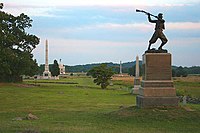

National Military Park, National Battlefield, National Battlefield Park, and National Battlefield Site are four designations for 25 battle sites preserved by the United States federal government because of their national importance. The designation applies to "sites where historic battles were fought on American soil during the armed conflicts that shaped the growth and development of the United States...."[1]
There are eleven National Battlefields (NB), nine National Military Parks (NMP), four National Battlefield Parks (NBP), and one National Battlefield Site (NBS). The National Park Service does not distinguish among the four designations in terms of their preservation or management policies.
Seventeen sites are from the American Civil War, four from the American Revolutionary War, one from the War of 1812, one from the French and Indian War, and two were attacks on Native Americans. Big Hole is the only site in the Western United States.
In 1890, Chickamauga and Chattanooga National Military Park was the first such site created by Congress. Originally these sites were maintained by the War Department, but were transferred to the National Park Service on August 10, 1933. The different designations appear to represent Congressional attitudes at the time of authorization of each individual site, although "park" appears to be reserved for the larger sites. Only Brices Cross Roads National Battlefield Site, which is small, still bears that designation; others have since been redesignated. Some battlefields are designated as National Monuments, such as Little Bighorn Battlefield National Monument, Mill Springs Battlefield National Monument, and ten forts, several of which saw battle; National Historical Parks, such as Harpers Ferry National Historical Park and Cedar Creek and Belle Grove National Historical Park; or National Historic Sites, such as Sand Creek Massacre National Historic Site.
As with all historic areas in the National Park System, these battle sites are automatically listed on the National Register of Historic Places.
List of areas
Other battlefields in the National Park System
National Memorials
- Arkansas Post National Memorial preserves the site of battles in 1783 and 1863
- Pearl Harbor National Memorial preserves sites related to the Attack on Pearl Harbor
- Perry's Victory and International Peace Memorial commemorates the Battle of Lake Erie
National Monuments
- Aleutian Islands World War II National Monument preserves the site of the Battle of Attu
- Canyon de Chelly National Monument preserves the site of the Battle of Canyon de Chelly
- Castillo de San Marcos National Monument preserves a Spanish fort involved in numerous sieges
- Fort McHenry National Monument preserves Fort McHenry which played a crucial role in the Battle of Baltimore
- Fort Pulaski National Monument preserves Fort Pulaski, site of the Siege of Fort Pulaski
- Fort Stanwix National Monument preserves Fort Stanwix, site of the Siege of Fort Stanwix
- Little Bighorn Battlefield National Monument preserves the site of the Battle of the Little Bighorn
- Mill Springs Battlefield National Monument preserves the site of the Battle of Mill Springs
- Pacific Remote Islands Marine National Monument includes Wake Island, site of the Battle of Wake Island
- Papahānaumokuākea Marine National Monument includes Midway Atoll, involved in the Battle of Midway
National Historical Parks
- Appomattox Court House National Historical Park preserves the site of the Battle of Appomattox Court House
- Boston National Historical Park preserves several sites of the American Revolutionary War, including the Battle of Bunker Hill
- Cedar Creek and Belle Grove National Historical Park preserves the site of the Battle of Cedar Creek
- Colonial National Historical Park preserves the site of the Siege of Yorktown
- Fort Sumter and Fort Moultrie National Historical Park preserves Fort Sumter and Fort Moultrie, involved in battles including the Battle of Fort Sumter and the Battle of Sullivan's Island
- Harpers Ferry National Historical Park preserves Harpers Ferry, West Virginia, the site of John Brown's Raid on Harpers Ferry and the Battle of Harpers Ferry
- Jean Lafitte National Historical Park preserves the Chalmette Battlefield, site of the Battle of New Orleans
- Minute Man National Historical Park preserves sites related to the Battles of Lexington and Concord
- Nez Perce National Historical Park preserves sites of various battles of the Nez Perce War
- Palo Alto Battlefield National Historical Park preserves the site of the Battle of Palo Alto
- Pecos National Historical Park preserves the site of the Battle of Glorieta Pass
- Saratoga National Historical Park preserves the site of the Battles of Saratoga
- Sitka National Historical Park preserves the site of the Battle of Sitka
- War in the Pacific National Historical Park preserves sites related to the Battle of Guam (1944)
National Historic Sites
- Fallen Timbers Battlefield and Fort Miamis National Historic Site preserves the site of the Battle of Fallen Timbers
- Fort Bowie National Historic Site preserves the site of the Battle of Apache Pass
- Sand Creek Massacre National Historic Site preserves the site of the Sand Creek Massacre
- Springfield Armory National Historic Site preserves the site of Shays' Rebellion
- Washita Battlefield National Historic Site preserves the site of the Battle of Washita River
- Whitman Mission National Historic Site preserves the site of the Whitman massacre
Affiliated areas
The following are affiliated areas of the National Park Services that are battlegrounds
- Eutaw Springs Battlefield preserves the site of the Battle of Eutaw Springs
- Kettle Creek Battlefield preserves the site of the Battle of Kettle Creek
- Parkers Crossroads Battlefield preserves the site of the Battle of Parker's Cross Roads
See also
Notes
- ^ American Battlefield Protection Act of 1996
- ^ "Park Anniversaries". Retrieved August 13, 2021.
- ^ "National Park Service Acreage Reports". Retrieved August 13, 2021.
External links
- Designation of National Park System Units
- The Origin & Evolution of the National Military Park Idea by Ronald F. Lee (1973)

































